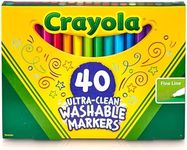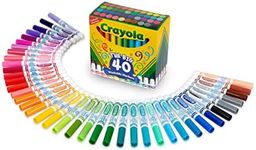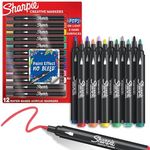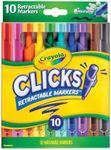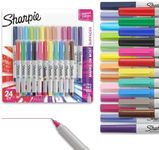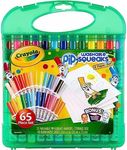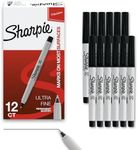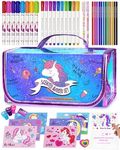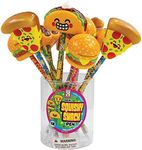Buying Guide for the Best Drawing Markers
Choosing the right drawing markers can significantly impact your artwork, whether you're a professional artist, a hobbyist, or a student. The right markers can enhance your creativity, provide the desired effects, and ensure your work looks its best. To make an informed decision, it's essential to understand the key specifications and how they align with your needs and preferences.Ink TypeInk type refers to the kind of ink used in the markers, which can be water-based, alcohol-based, or solvent-based. Water-based inks are great for blending and are less likely to bleed through paper, making them ideal for beginners and casual artists. Alcohol-based inks dry quickly and are permanent, offering vibrant colors and smooth blending, suitable for professional artists. Solvent-based inks are durable and can write on various surfaces, perfect for industrial or outdoor use. Choose the ink type based on your project requirements and the surfaces you will be working on.
Tip Shape and SizeThe tip shape and size of a marker determine the kind of lines and details you can achieve. Fine tips are excellent for detailed work and intricate designs, while broad tips are better for filling in large areas and creating bold lines. Brush tips offer versatility, allowing for both fine and broad strokes, mimicking the feel of a paintbrush. Consider the type of artwork you do most often; if you need precision, go for fine tips, and if you need to cover large areas, broad tips or brush tips might be more suitable.
Color RangeThe color range of a marker set refers to the variety of colors available. Some sets offer a limited palette, while others provide an extensive range of hues. A broader color range allows for more creativity and detailed work, as you can achieve more subtle gradients and shading. If you're a beginner or working on simple projects, a basic set with primary and secondary colors might suffice. For more complex and professional work, a set with a wide array of colors will be more beneficial.
BlendabilityBlendability is the ability of the markers to mix and blend with each other to create smooth transitions and gradients. Alcohol-based markers are known for their excellent blendability, making them a favorite among professional artists. Water-based markers can also blend well but may require more skill and practice. If your artwork involves a lot of shading and color transitions, prioritize markers with high blendability. For simpler, more straightforward coloring, blendability might be less critical.
LightfastnessLightfastness refers to how resistant the marker ink is to fading when exposed to light over time. High lightfastness ensures that your artwork remains vibrant and does not deteriorate quickly. This is particularly important for professional artists whose work will be displayed or sold. If your work is intended for long-term display, choose markers with high lightfastness ratings. For casual or temporary projects, lightfastness may be less of a concern.
Refillability and Replaceable TipsRefillability and replaceable tips refer to whether the markers can be refilled with ink and if the tips can be replaced when worn out. Refillable markers and replaceable tips are more cost-effective and environmentally friendly in the long run. They are ideal for artists who use markers frequently and want to maintain their tools without constantly buying new ones. If you are a heavy user or a professional, consider markers with these features. For occasional use, non-refillable markers might be more convenient.
